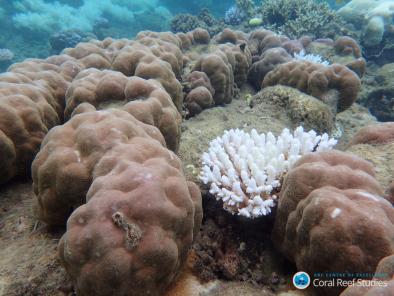Science Source
Incorporating adaptive responses into future projections of coral bleaching
Earlier modeling work suggested that coral reefs would be gone by the middle of this century. Our study shows that if corals can adapt to warming that has occurred over the past 40 to 60 years, some coral reefs may persist through the end of this century.
Cheryl Logan, study lead and assistant professor in California State University Monterey Bay’s Division of Science and Environmental Policy
- States that climate warming threatens to increase mass coral bleaching events, and several studies have projected the demise of tropical coral reefs this century
- States that recent evidence indicates corals may be able to respond to thermal stress though adaptive processes (e.g., genetic adaptation, acclimatization, and symbiont shuffling)
- Study compares how different adaptive processes could affect coral bleaching projections
- Uses the latest bias-corrected global sea surface temperature (SST) output from the NOAA/GFDL Earth System Model 2 (ESM2M) for the preindustrial period through 2100 to project coral bleaching trajectories
- Initial results showed that, in the absence of adaptive processes, application of a preindustrial climatology to the NOAA Coral Reef Watch bleaching prediction method overpredicts the present-day bleaching frequency
- Results suggest that corals may have already responded adaptively to some warming over the industrial period
- Modifies the prediction method so that the bleaching threshold either permanently increased in response to thermal history (e.g., simulating directional genetic selection) or temporarily increased for 2–10 years in response to a bleaching event (e.g., simulating symbiont shuffling)
- Finds that a bleaching threshold that changes relative to the preceding 60 years of thermal history reduced the frequency of mass bleaching events by 20–80% compared with the ‘no adaptive response’ prediction model by 2100, depending on the emissions scenario
- Finds that when both types of adaptive responses were applied, up to 14% more reef cells avoided high-frequency bleaching by 2100
- Finds, however, that temporary increases in bleaching thresholds alone only delayed the occurrence of high-frequency bleaching by ca. 10 years in all but the lowest emissions scenario
Related Content
Headline

Apr 18, 2018 | Washington Post
Global warming has changed the Great Barrier Reef ‘forever,’ scientists say
Science Source
| World Weather Attribution
Great Barrier Reef Bleaching, March 2016
Science Source
| Proceedings of the National Academy of Sciences
Ocean acidification affects coral growth by reducing skeletal density
Nathaniel R. Mollica, Weifu Guo, Anne L. Cohen et al
Science Source
| PLOS ONE
Coral physiology and microbiome dynamics under combined warming and ocean acidification
Andréa G. Grottoli, Paula Dalcin Martins, Michael J. Wilkins et al


